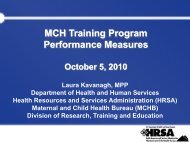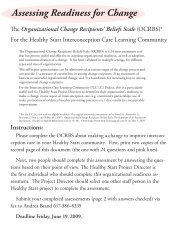(STROBE) Statement
(STROBE) Statement
(STROBE) Statement
Create successful ePaper yourself
Turn your PDF publications into a flip-book with our unique Google optimized e-Paper software.
Epidemiology Volume 18, Number 6, November 2007 <strong>STROBE</strong> Initiative for Reporting Observational Studies<br />
quality of reports of randomized trials. 14,15 Similar initiatives<br />
have followed for other research areas—eg, for the reporting<br />
of meta-analyses of randomized trials 16 or diagnostic studies.<br />
17 We established a network of methodologists, researchers,<br />
and journal editors to develop recommendations for the<br />
reporting of observational research: the Strengthening the<br />
Reporting of Observational Studies in Epidemiology<br />
(<strong>STROBE</strong>) <strong>Statement</strong>.<br />
Aims and Use of the <strong>STROBE</strong> <strong>Statement</strong><br />
The <strong>STROBE</strong> <strong>Statement</strong> is a checklist of items that<br />
should be addressed in articles reporting on the 3 main study<br />
designs of analytical epidemiology: cohort, case-control, and<br />
cross-sectional studies. The intention is solely to provide<br />
guidance on how to report observational research well: these<br />
recommendations are not prescriptions for designing or conducting<br />
studies. Also, while clarity of reporting is a prerequisite<br />
to evaluation, the checklist is not an instrument to<br />
evaluate the quality of observational research.<br />
Here we present the <strong>STROBE</strong> <strong>Statement</strong> and explain<br />
how it was developed. In a detailed companion paper, the<br />
Explanation and Elaboration article, 18–20 we justify the<br />
inclusion of the different checklist items and give methodological<br />
background and published examples of what we<br />
consider transparent reporting. We strongly recommend<br />
using the <strong>STROBE</strong> checklist in conjunction with the explanatory<br />
article, which is available freely on the websites of PLoS<br />
Medicine (www.plosmedicine.org), Annals of Internal Medicine<br />
(www.annals.org), and EPIDEMIOLOGY (www.epidem.com).<br />
Development of the <strong>STROBE</strong> <strong>Statement</strong><br />
We established the <strong>STROBE</strong> Initiative in 2004, obtained<br />
funding for a workshop and set up a website<br />
(www.strobe-statement.org). We searched textbooks, bibliographic<br />
databases, reference lists, and personal files for<br />
relevant material, including previous recommendations,<br />
empirical studies of reporting and articles describing relevant<br />
methodological research. Because observational research<br />
makes use of many different study designs, we felt<br />
that the scope of <strong>STROBE</strong> had to be clearly defined early<br />
on. We decided to focus on the 3 study designs that are<br />
used most widely in analytical observational research:<br />
cohort, case-control, and cross-sectional studies.<br />
We organized a 2-day workshop in Bristol, UK, in<br />
September 2004. 23 individuals attended this meeting, including<br />
editorial staff from Annals of Internal Medicine,<br />
BMJ, Bulletin of the World Health Organization, International<br />
Journal of Epidemiology, JAMA, Preventive Medicine,<br />
and The Lancet, as well as epidemiologists, methodologists,<br />
statisticians, and practitioners from Europe and North America.<br />
Written contributions were sought from 10 other individuals<br />
who declared an interest in contributing to <strong>STROBE</strong>, but<br />
could not attend. Three working groups identified items<br />
deemed to be important to include in checklists for each type<br />
of study. A provisional list of items prepared in advance<br />
(available from our website) was used to facilitate discussions.<br />
The 3 draft checklists were then discussed by all<br />
participants and, where possible, items were revised to make<br />
them applicable to all three study designs. In a final plenary<br />
session, the group decided on the strategy for finalizing and<br />
disseminating the <strong>STROBE</strong> statement.<br />
After the workshop we drafted a combined checklist<br />
including all three designs and made it available on our<br />
website. We invited participants and additional scientists and<br />
editors to comment on this draft checklist. We subsequently<br />
published 3 revisions on the website, and 2 summaries of<br />
comments received and changes made. During this process<br />
the coordinating group (ie, the authors of the present paper)<br />
met on eight occasions for 1 or 2 days and held several<br />
telephone conferences to revise the checklist and to prepare<br />
the present paper and the Explanation and Elaboration<br />
paper. 18–20 The coordinating group invited 3 additional coauthors<br />
with methodological and editorial expertise to help<br />
write the Explanation and Elaboration paper, and sought<br />
feedback from more than 30 people, who are listed at the end<br />
of this paper. We allowed several weeks for comments on<br />
subsequent drafts of the paper and reminded collaborators<br />
about deadlines by e-mail.<br />
<strong>STROBE</strong> Components<br />
The <strong>STROBE</strong> statement is a checklist of 22 items that<br />
we consider essential for good reporting of observational<br />
studies (Table 1). These items relate to the article’s title and<br />
abstract (item 1), the introduction (items 2 and 3), methods<br />
(items 4–12), results (items 13–17), and discussion sections<br />
(items 18–21) and other information (item 22 on funding). 18<br />
items are common to all three designs, while four (items 6,<br />
12, 14, and 15) are design-specific, with different versions for<br />
all or part of the item. For some items (indicated by asterisks),<br />
information should be given separately for cases and controls<br />
in case-control studies, or exposed and unexposed groups in<br />
cohort and cross-sectional studies. Although presented here<br />
as a single checklist, separate checklists are available for each<br />
of the 3 study designs on the <strong>STROBE</strong> website.<br />
Implications and Limitations<br />
The <strong>STROBE</strong> statement was developed to assist authors<br />
when writing up analytical observational studies, to<br />
support editors and reviewers when considering such articles<br />
for publication, and to help readers when critically appraising<br />
published articles. We developed the checklist through an<br />
open process, taking into account the experience gained with<br />
previous initiatives, in particular CONSORT. We reviewed<br />
the relevant empirical evidence as well as methodological<br />
work, and subjected consecutive drafts to an extensive iterative<br />
process of consultation. The checklist presented here is<br />
thus based on input from a large number of individuals with<br />
diverse backgrounds and perspectives. The comprehensive<br />
© 2007 the authors 801




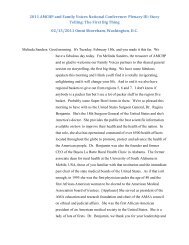


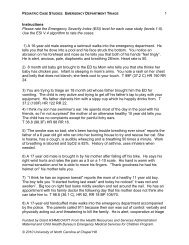
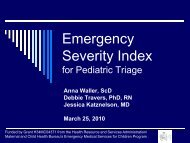
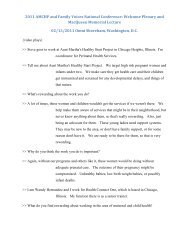
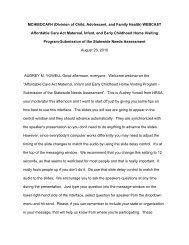
![Hormone Disruptors and Women's Health: Reasons for Concern [PDF]](https://img.yumpu.com/19410002/1/190x245/hormone-disruptors-and-womens-health-reasons-for-concern-pdf.jpg?quality=85)

